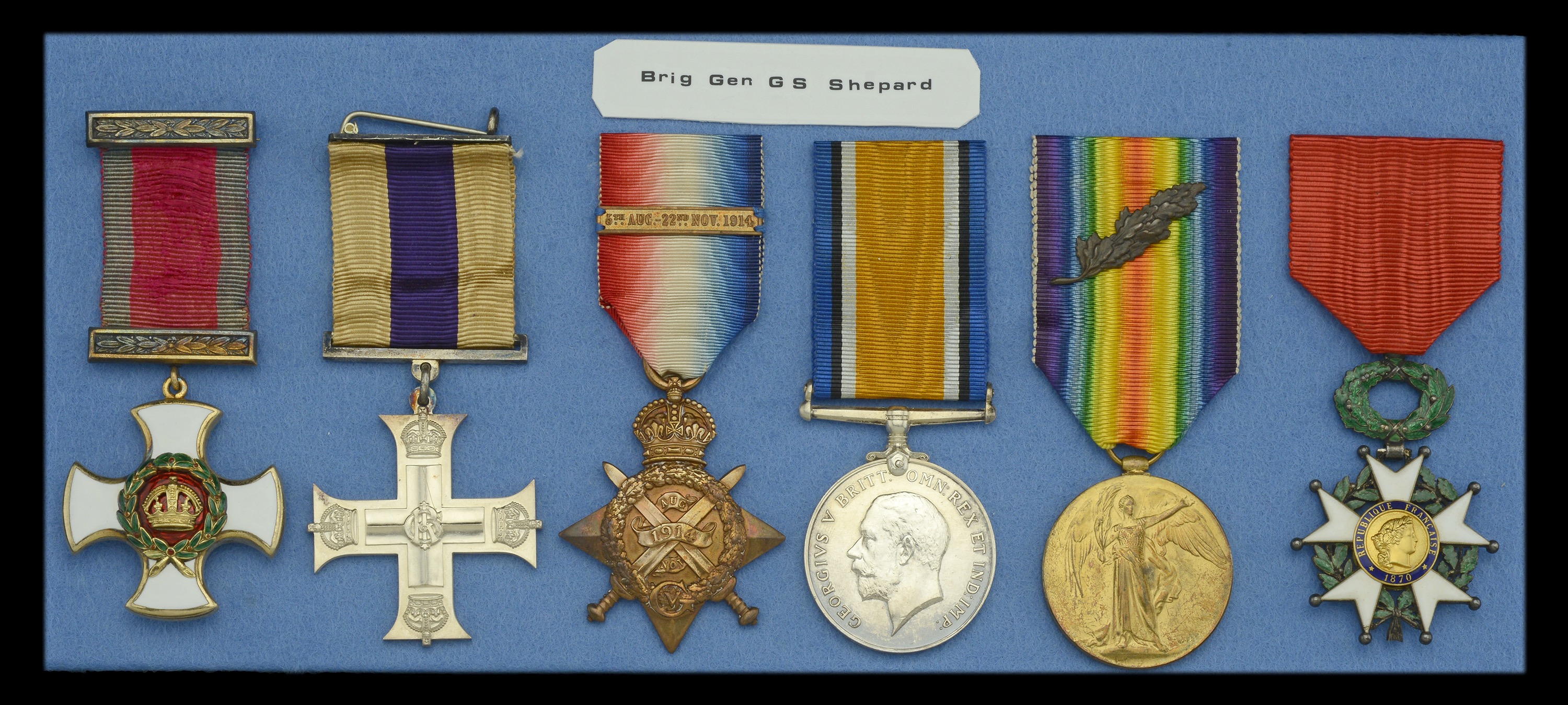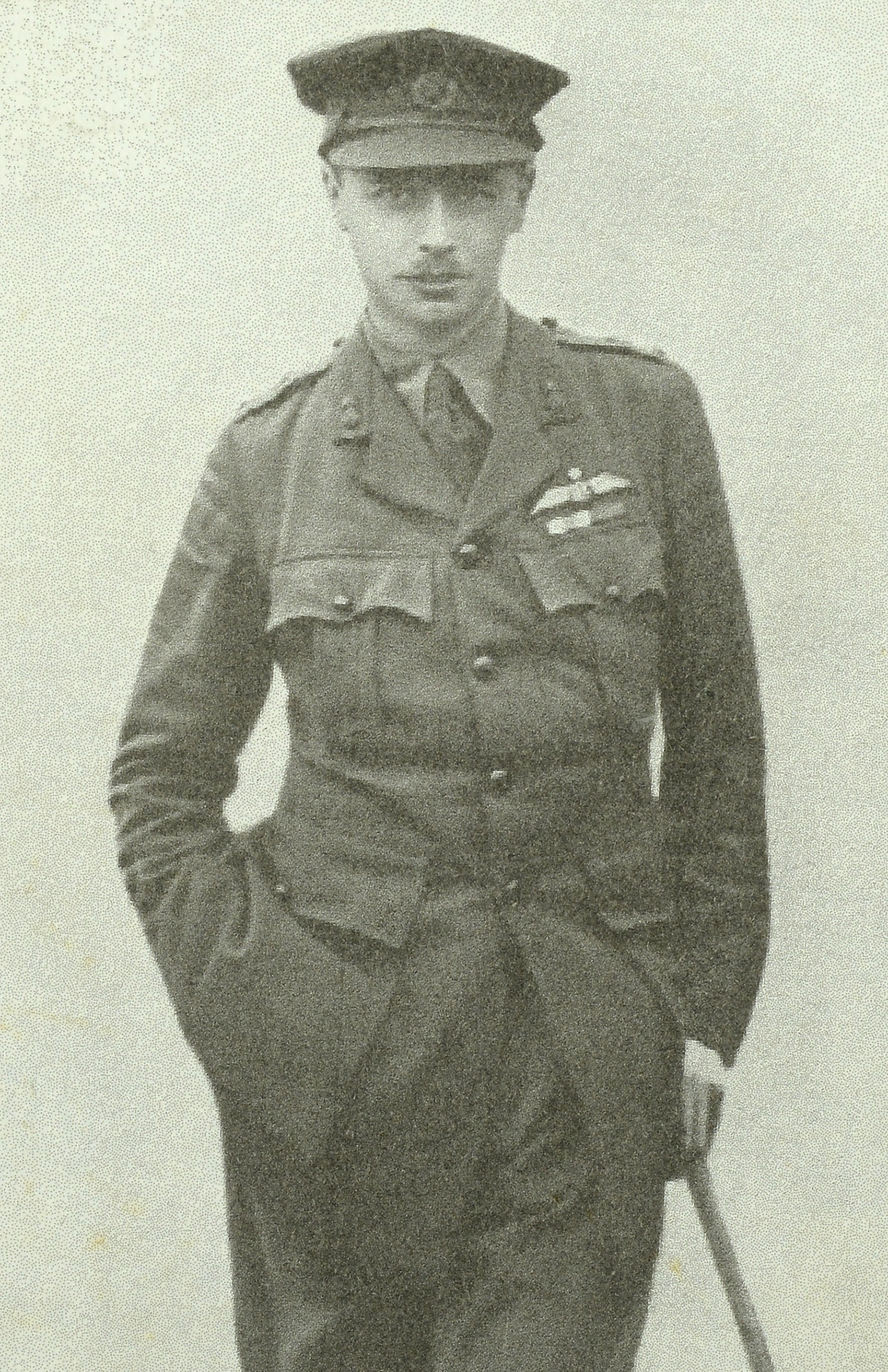17
The important Great War pilot's D.S.O., M.C., 'August 1914' Legion of Honour group of six...
Bids do not include VAT, buyer’s premium or delivery.
By confirming your bid, you agree that you have read and accepted the-saleroom.com and the auctioneer's terms and conditions. Confirming your bid is a legally binding obligation to purchase and pay for the lot should your bid be successful.
Choose one of the quick bid options below:
Bids do not include VAT, buyer’s premium or delivery.
By confirming your bid, you agree that you have read and accepted the-saleroom.com and the auctioneer's terms and conditions. Confirming your bid is a legally binding obligation to purchase and pay for the lot should your bid be successful.
The important Great War pilot’s D.S.O., M.C., ‘August 1914’ Legion of Honour group of six awarded to Brigadier General G. S. Shephard, Royal Flying Corps. An adventurer, ‘gunrunner’ and gallant airman who courted controversy by ‘spying’ on strategic places around the German seaboard immediately prior to the Great War - only to then use his yachting prowess to help his friend Erskine Childers provide 900 rifles with 25,000 rounds of ammunition to the South Irish Volunteers, 26 July 1914. Childers went on to become an associate of Michael Collins (and was executed by firing squad in 1922), whilst Shephard, a serving British Army officer, was perhaps spared further inquiry by the outbreak of the Great War.
Shephard served as a Flight Commander with 4 Squadron, and a flew a B.E. 2 over to France as part of the original R.F.C. contingent, 13 August 1914. He flew in the early reconnaissance missions of the Great War, including during the retreat from Mons, 24 August 1914, when his report saved the British forces from being outmanoeuvred and over run by von Kluck’s Second Corps.
Shephard commanded 6 Squadron from March 1915, before commanding 12th (Corps) Wing throughout the Battle of the Somme, July - November 1916. He commanded I Brigade, R.F.C. during the Arras offensive of 1917, and became the highest ranking officer in the flying services to be killed whilst on active service during the Great War, 8 January 1918 - when he crashed his Nieuport Scout carrying out a squadron visit.
Loved by the men that he commanded, ‘he was accorded a military funeral with full honours at Lapugnoy, not far from Bruay. Some twenty Generals and a thousand officers attended the funeral, which was preceded by Canadian pipers and a firing party’
Distinguished Service Order, G.V.R., silver-gilt and enamel, with integral top riband bar; Military Cross, G.V.R., unnamed as issued, with top riband bar; 1914 Star, with clasp (Capt. G. S. Shephard. R. Fus: Attd: R.F.C.); British War and Victory Medals, with M.I.D. oak leaves (Brig. Gen. G. S. Shephard.); France, Third Republic, Legion of Honour, Chevalier’s breast badge, silver, silver-gilt, and enamel, mounted on card for display, nearly extremely fine (6) £8,000-£12,000
---
D.S.O. London Gazette 4 June 1917.
M.C. London Gazette 18 February 1915 [The 7th M.C. awarded to the Royal Flying Corps, the previous 6 being announced in the New Years Honours List of 1915].
M.I.D. London Gazette 17 February 1915, 1 January 1916, 2 January 1917, 9 April 1917, 7 November 1917 and 20 May 1918.
France, Legion of Honour, Chevalier London Gazette 3 November 1914:
‘For gallantry during operations between 21st and 30th August 1914.’
Gordon Strachey Shephard was born in Madras, India in July 1885. He was the eldest son of Sir Horatio Hale Shephard (Advocate-General of the Madras Presidency, and later Chief Justice of the Madras High Court) of 58 Montagu Square, London, and brother of Captain J. W. Shephard, M.C. (see Lot 24).
Shephard was named after General Gordon, who was killed in Khartoum in the same year as his birth. He was educated at Summer Fields, Eton and Sandhurst. Shephard was commissioned Second Lieutenant in the Royal Fusiliers in October 1905. He was an outstanding yachtsman and is thought to have ‘spied’ on strategic places around the German seaboard in the manner of the heroes of Erskine Childers’ fictional novel, The Riddle of the Sands. Perhaps this was no mere coincidence, given that Shephard knew Childers well.
Shephard’s covert operations came to an abrupt halt when and a companion were briefly detained by the German authorities at Emden, after injudiciously taking photographs in a sensitive area. Fortunately for him, Shephard was released without charge and returned to the UK to begin learning how to fly. He gained his Royal Aero Club Certificate (No. 215) on a Bristol aircraft at Brooklands, 14 May 1912. Shephard was attached to the Royal Flying Corps from July 1912, and was initially focussed on the use of airships for military purposes.
It was Shephard’s friendship with Childers that drew him into an action which could have ended not only his military career, but his freedom. The two of them shared a place in the complicated world of Anglo-Irish history, buy securing the first arms for the South Irish Volunteers. Together with two fishermen for crew (and Mrs Childers and a female companion to allay the would-be suspicions of interested coastguards) they took delivery in Childers’ 28-ton ketch Asgard of 900 rifles and 25,000 rounds of ammunition. Procured from German agents off the German coast, and delivered by Childers to Howth, near Dublin, 26 July 1914. In other words the two were gunrunners - one a Captain in the British Army on leave from his regiment, and the other a republican zealot.
Childers at that time had not renounced his British citizenship, and thus it was that the first consignment of arms to the south of Ireland was delivered by two Englishmen. The outbreak of the war in Europe may well have been fortunate timing as far as Shephard’s military career was concerned. The authorities became occupied with fighting Germany, before his role in this gunrunning could be fully investigated.
Appointed a Flight Commander with 4 Squadron, Shephard accompanied the original Royal Flying Corps contingent to France by piloting a B.E.2, 13 August 1914:
‘By the evening of August 12 the machines of the squadron were at Dover, and on the morning of the 13th they were awaiting final orders to proceed to France. Captain Shephard was the first to start, having been ordered to select and mark a good landing-place. All, but a few of the machines which sustained minor damage, safely crossed the Channel, and on August 16 the squadron, in company with Nos. 2 and 3 Squadrons, proceeded to Maugbeuge from Amiens. Not until the morning of August 19, 1914, were the first reconnaissances of the Royal Flying Corps carried out by Lieutenant G. W. Mapplebeck, of No. 4 Squadron, flying a B.E.
The War Diary of the R.F.C. gives some glimpses to fill up the very discreet background of Gordon’s letters home. On August 20 “Captain Shephard and Prince Murat sent to Mons to reconnoitre landing-ground and also area to west of Solignies.” On August 22, with Lieutenant Bonham-Carter as observer, he carried out Reconnaissance No. 10 in the history of the R.F.C. at war.
At 8.15 am on the morning of August 22, Captain Shephard, with Lieutenant I. M. Bonham-Carter as observer, flying the machine in which he had crossed to France, made his first reconnaissance. The original reconnaissance report of Lieutenant Mapplebeck is missing, and Captain Shephard’s report of August 22, 1914, is thus the first report of a reconnaissance to be recorded in the War Diary of No. 4 Squadron.
On this date, says Sir Walter Raleigh (The War in the Air, Vol. I, p 301), “there were twelve reconnaissances which revealed the presence of large bodies of troops moving in the direction of the British front, and did much to dissipate the fog of war. The first machine to return came in soon after eleven. This was piloted by Captain G. S. Sheph...
The important Great War pilot’s D.S.O., M.C., ‘August 1914’ Legion of Honour group of six awarded to Brigadier General G. S. Shephard, Royal Flying Corps. An adventurer, ‘gunrunner’ and gallant airman who courted controversy by ‘spying’ on strategic places around the German seaboard immediately prior to the Great War - only to then use his yachting prowess to help his friend Erskine Childers provide 900 rifles with 25,000 rounds of ammunition to the South Irish Volunteers, 26 July 1914. Childers went on to become an associate of Michael Collins (and was executed by firing squad in 1922), whilst Shephard, a serving British Army officer, was perhaps spared further inquiry by the outbreak of the Great War.
Shephard served as a Flight Commander with 4 Squadron, and a flew a B.E. 2 over to France as part of the original R.F.C. contingent, 13 August 1914. He flew in the early reconnaissance missions of the Great War, including during the retreat from Mons, 24 August 1914, when his report saved the British forces from being outmanoeuvred and over run by von Kluck’s Second Corps.
Shephard commanded 6 Squadron from March 1915, before commanding 12th (Corps) Wing throughout the Battle of the Somme, July - November 1916. He commanded I Brigade, R.F.C. during the Arras offensive of 1917, and became the highest ranking officer in the flying services to be killed whilst on active service during the Great War, 8 January 1918 - when he crashed his Nieuport Scout carrying out a squadron visit.
Loved by the men that he commanded, ‘he was accorded a military funeral with full honours at Lapugnoy, not far from Bruay. Some twenty Generals and a thousand officers attended the funeral, which was preceded by Canadian pipers and a firing party’
Distinguished Service Order, G.V.R., silver-gilt and enamel, with integral top riband bar; Military Cross, G.V.R., unnamed as issued, with top riband bar; 1914 Star, with clasp (Capt. G. S. Shephard. R. Fus: Attd: R.F.C.); British War and Victory Medals, with M.I.D. oak leaves (Brig. Gen. G. S. Shephard.); France, Third Republic, Legion of Honour, Chevalier’s breast badge, silver, silver-gilt, and enamel, mounted on card for display, nearly extremely fine (6) £8,000-£12,000
---
D.S.O. London Gazette 4 June 1917.
M.C. London Gazette 18 February 1915 [The 7th M.C. awarded to the Royal Flying Corps, the previous 6 being announced in the New Years Honours List of 1915].
M.I.D. London Gazette 17 February 1915, 1 January 1916, 2 January 1917, 9 April 1917, 7 November 1917 and 20 May 1918.
France, Legion of Honour, Chevalier London Gazette 3 November 1914:
‘For gallantry during operations between 21st and 30th August 1914.’
Gordon Strachey Shephard was born in Madras, India in July 1885. He was the eldest son of Sir Horatio Hale Shephard (Advocate-General of the Madras Presidency, and later Chief Justice of the Madras High Court) of 58 Montagu Square, London, and brother of Captain J. W. Shephard, M.C. (see Lot 24).
Shephard was named after General Gordon, who was killed in Khartoum in the same year as his birth. He was educated at Summer Fields, Eton and Sandhurst. Shephard was commissioned Second Lieutenant in the Royal Fusiliers in October 1905. He was an outstanding yachtsman and is thought to have ‘spied’ on strategic places around the German seaboard in the manner of the heroes of Erskine Childers’ fictional novel, The Riddle of the Sands. Perhaps this was no mere coincidence, given that Shephard knew Childers well.
Shephard’s covert operations came to an abrupt halt when and a companion were briefly detained by the German authorities at Emden, after injudiciously taking photographs in a sensitive area. Fortunately for him, Shephard was released without charge and returned to the UK to begin learning how to fly. He gained his Royal Aero Club Certificate (No. 215) on a Bristol aircraft at Brooklands, 14 May 1912. Shephard was attached to the Royal Flying Corps from July 1912, and was initially focussed on the use of airships for military purposes.
It was Shephard’s friendship with Childers that drew him into an action which could have ended not only his military career, but his freedom. The two of them shared a place in the complicated world of Anglo-Irish history, buy securing the first arms for the South Irish Volunteers. Together with two fishermen for crew (and Mrs Childers and a female companion to allay the would-be suspicions of interested coastguards) they took delivery in Childers’ 28-ton ketch Asgard of 900 rifles and 25,000 rounds of ammunition. Procured from German agents off the German coast, and delivered by Childers to Howth, near Dublin, 26 July 1914. In other words the two were gunrunners - one a Captain in the British Army on leave from his regiment, and the other a republican zealot.
Childers at that time had not renounced his British citizenship, and thus it was that the first consignment of arms to the south of Ireland was delivered by two Englishmen. The outbreak of the war in Europe may well have been fortunate timing as far as Shephard’s military career was concerned. The authorities became occupied with fighting Germany, before his role in this gunrunning could be fully investigated.
Appointed a Flight Commander with 4 Squadron, Shephard accompanied the original Royal Flying Corps contingent to France by piloting a B.E.2, 13 August 1914:
‘By the evening of August 12 the machines of the squadron were at Dover, and on the morning of the 13th they were awaiting final orders to proceed to France. Captain Shephard was the first to start, having been ordered to select and mark a good landing-place. All, but a few of the machines which sustained minor damage, safely crossed the Channel, and on August 16 the squadron, in company with Nos. 2 and 3 Squadrons, proceeded to Maugbeuge from Amiens. Not until the morning of August 19, 1914, were the first reconnaissances of the Royal Flying Corps carried out by Lieutenant G. W. Mapplebeck, of No. 4 Squadron, flying a B.E.
The War Diary of the R.F.C. gives some glimpses to fill up the very discreet background of Gordon’s letters home. On August 20 “Captain Shephard and Prince Murat sent to Mons to reconnoitre landing-ground and also area to west of Solignies.” On August 22, with Lieutenant Bonham-Carter as observer, he carried out Reconnaissance No. 10 in the history of the R.F.C. at war.
At 8.15 am on the morning of August 22, Captain Shephard, with Lieutenant I. M. Bonham-Carter as observer, flying the machine in which he had crossed to France, made his first reconnaissance. The original reconnaissance report of Lieutenant Mapplebeck is missing, and Captain Shephard’s report of August 22, 1914, is thus the first report of a reconnaissance to be recorded in the War Diary of No. 4 Squadron.
On this date, says Sir Walter Raleigh (The War in the Air, Vol. I, p 301), “there were twelve reconnaissances which revealed the presence of large bodies of troops moving in the direction of the British front, and did much to dissipate the fog of war. The first machine to return came in soon after eleven. This was piloted by Captain G. S. Sheph...
Orders, Decorations, Medals and Militaria
Sale Date(s)
Venue Address
General delivery information available from the auctioneer
If you are successful in purchasing lot/s being auctioned by us and opt for the item/s to be sent to you, we will use the following methods of shipment:
Within the UK
If you live within the UK, items will be despatched using Royal Mail Special Delivery. This service provides parcel tracking (via the Royal Mail website) and next weekday delivery (betwen 9am and 1pm). Items delivered within the UK are covered by our insurance company. Heavy and bulky lots will be sent by courier, in discussion with the client.
Outside of the UK
If the item/s being sent are worth under £1000 in total they are sent using Royal Mail’s Signed For International service. This ensures the item must be signed for when it is delivered.
If the item/s being sent are valued at over £1000 in total they will be sent using FedEx. This service allows next day delivery to customers in many parts of the US and parcels are fully trackable using the FedEx website.
Shipping Exceptions
Certain lots such as those containing glass or sharp implements, etc., may not be suitable for in-house shipping within or outside of the UK. Please contact Noonans with any queries.
Important Information
Auctioneer's Buyers Premium: 24% (+VAT)
There is an additional charge of 4.95% (+VAT/sales tax)














